Abstract
Device-to-device (D2D) communication is an essential part of the future fifth generation (5G) system that can be seen as a “network of networks,” consisting of multiple seamlessly-integrated radio access technologies (RATs). Public safety communications, autonomous driving, socially-aware networking, and infotainment services are example use cases of D2D technology. High data rate communications and use of several active air interfaces in the described network create energy consumption challenges for both base stations and the end user devices. In this paper, we review the status of 3rd Generation Partnership Project (3GPP) standardization, which is the most important standardization body for 5G systems. We define a set of application scenarios for D2D communications in 5G networks. We use the recent models of 3GPP long term evolution (LTE) and WiFi interfaces in analyzing the power consumption from both the infrastructure and user device perspectives. The results indicate that with the latest radio interfaces, the best option for energy saving is the minimization of active interfaces and sending the data with the best possible data rate. Multiple recommendations on how to exploit the results in future networks are given.
1. Introduction
Device-to-device (D2D) communications in infrastructure networks have been studied actively since the 1990s [1], due to the potential to reduce delays, increase throughput, and to improve power or energy efficiency. D2D enables cooperative services and data dissemination methods and can be used in coming 5G networks over various radio access technologies (RATs). Actively developed application areas currently include 3GPP proximity services, public safety communications, vehicle-to-everything (V2X) communications, autonomous ships, the Internet of Things (IoT) and wearables [1,2,3,4,5,6,7,8,9]. For instance, the number of wearable devices is predicted to grow from 325 million in 2016 to 929 million in 2021, when 7% of the devices may use in-built cellular connectivity [10]. Other devices, on the other hand, may obtain cellular access through e.g., smart phones.
An essential part of the use of D2D in the mentioned application areas is energy efficiency [11,12,13,14], which is heavily dependent on the used radio interfaces. In general, the role of WiFi and other small cell technologies is important, as 60% of mobile data was offloaded onto the fixed network through WiFi or femtocell in 2016 [10]. In addition, computing power is important, especially in short distance communication [15]. Compared to theoretical power control work, such as [16,17], one is able to estimate more accurately the resource use in a practical network if measurement-based models for air interfaces are available. The power consumption of different 3GPP long-term evolution (LTE) and WiFi interfaces has been actively measured and modelled in recent years [18,19,20,21,22]. Both user device and base station power consumption models are available. However, there is a lot of variation in measurement campaigns between different protocols and between different smart phone models.
Some of the differences can be explained by the new generation of air interfaces and partially the power consumption changes are due to the different use of the user devices. For example, social networking [23] generates a constant stream of traffic, causing the mobile device to frequently move between idle and connected states. Energy state transitions alone cost energy, but these transitions also cause excessive signaling overhead in (3GPP) networks. Mechanisms such as adaptive discontinuous reception (DRX), user equipment (UE) assistance, energy harvesting, and massive multiple-input multiple-output (MIMO) antenna systems at the base station side have been proposed to reduce the power consumption of LTE mobiles [24,25,26,27,28,29].
We analyzed the power consumption of user devices in D2D communications in [30] and studied the power consumption from the base station perspective in [31] using many different measurement-based LTE and WiFi models. In this paper, we extend and unify analysis of [30] and [31] and update the results with the latest power consumption models [32]. In addition, we review the status in 3GPP standardization of D2D communications, focusing especially on IoT, wearables, and V2X communications [33,34,35,36,37,38]. The analysis shows where the industry is going and deepens the discussion on energy efficiency aspects in depicted networks. We believe that quality of service (QoS) and priority management mechanisms such as network slicing [35,36] can also be used to improve the performance of D2D networks.
We will extend the state-of-the art in [11,12,13,14,15,16,17,18,19,20,21,22,23,24,25,26,27,28,29,30,31,32], summarizing the novelty of this paper as: (1) Review of the status of the 3GPP standardization, including a summary of D2D features of different releases of the standard. (2) Definition of a set of D2D application scenarios with multiple data delivery options. (3) Analysis of the power consumption of the network in the depicted scenarios using measurement-based models. The 5G system will be a multi-RAT (radio access technologies (RATs)) system that enables seamless interworking between those RATs. Unlike previous works, we will consider both end user and base station perspectives in this paper. There are no measurement-based models of new 5G interfaces available yet, but there are LTE and WiFi models that will be an essential part of the coming 5G system. Therefore, we use the latest LTE-advanced and WiFi power consumption models in the analysis.
The paper is structured as follows. Section 2 reviews the status of 3GPP standardization. The system model and the use cases for analysis are defined in Section 3. The selected measurement-based power consumption models are described in Section 4. Performance analysis models from base station and end user device perspectives are depicted in Section 5, and the results given in Section 6 and Section 7 provides recommendations based on the conducted analysis. Section 8 concludes the paper.
2. Advances within 3GPP Standardization on D2D
3GPP specified the basic functionalities for D2D communications in release 12, where the main motivation was to develop a global standard for public safety communications [37]. However, the application scenario of 3GPP proximity services (ProSe) was not limited to public safety, D2D extension of conventional cellular services was also considered [38]. The basic architecture of the 3GPP ProSe is shown in Figure 1. A UE (user equipment) that wants to use ProSe must first contact the ProSe function through the logical interface named PC3 to get authorization and security parameters. After the discovery request and response message exchange via PC3 is completed, the UE can start the direct discovery process to find other UEs with ProSe cabability in their proximity using the PC5 interface. When two (or more) ProSe-enabled UEs have discovered each other, they can start direct communication over the direct link between them.
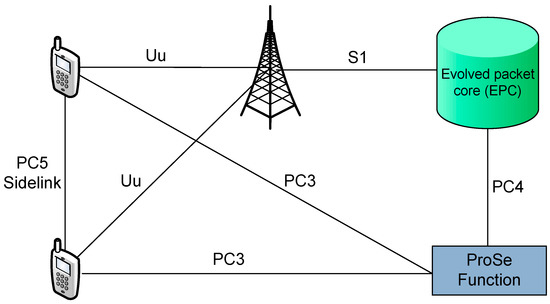
Figure 1.
Architecture and logical interfaces for proximity services (ProSe); PC: Interface between ProSe components; S1: interface between base station and the core network; Uu: Air interface.
The physical interface between two ProSe UEs is called sidelink. Time-frequency resources for the sidelink are shared with the uplink (UL), and the sidelink waveform is also similar to the single-carrier frequency-division multiple access (SC-FDMA) UL waveform. As ProSe was originally designed for public safety group communications, the sidelink transmission is based on multicasting with no hybrid automatic repeat request (HARQ) feedback. Instead, each medium access control (MAC) protocol data unit (PDU) is retransmitted three times with a different redundancy version for each transmission. Dedicated resource pools are allocated for sidelink transmissions in order to avoid collisions between them and conventional UL transmissions. The subframes and physical resource blocks (PRBs) belonging to sidelink resource pools are broadcasted as system information to UEs. Resources within a resource pool can be allocated by an evolved NodeB (eNB) (Mode 1) or they can be autonomously selected by a UE (Mode 2) [39], which enables sidelink communication when a UE is not within the cell coverage. ProSe communication was further enhanced in release 13 e.g., by allowing a UE to operate as a relay for another UE. The relaying was implemented at layer three in such a simple way that the network cannot differentiate the traffic of the remote UE from that of the relay UE. This limits the ability of the operator to treat the remote UE as a separate device for billing and security [40].
Service requirements related to the 5G system [41] consider D2D in two different ways. The first one uses direct device connection without any network entity in the middle. In the second approach, a relay UE is between a UE and the 5G network. This is called indirect network connection mode. The relay UE may use multiple access schemes such as 5G RAT, LTE, WiFi, and fixed broadband. Service continuity plays a key role when changing from one relay UE to another or to the direct network connection mode. In addition, the 5G system is expected to support the battery consumption optimization of relay UEs.
2.1. IoT and Wearables
IoT devices with a very long expected battery lifetime and wearables with other cellular-connected devices in their proximity would especially benefit from short D2D links. Motivated by this, 3GPP opened a release 15 study item “Study on Further Enhancements to LTE Device to Device, UE to Network Relays for IoT and Wearables” [42]. The primary objective of the study was to improve the power efficiency of the remote UEs (IoT devices and wearables) by allowing them to form a D2D connection with a UE who is willing to act as a relay [40]. Enhancements were planned to release 13 UE-to-network relaying to support end-to-end security and QoS as well as efficient path switching between conventional and D2D air interfaces. In addition, the needed changes for sidelink were studied to provide a reliable D2D communication link for low cost and low power IoT devices.
The study considered a diverse group of scenarios that could benefit from UE-to-network relaying. From the coverage point of view, the remote UE could be located within the cell, out of cell, or can be operating in the coverage-enhanced mode [40]. As cellular IoT devices mainly reach enhanced coverage by a high number (up to 2048) of repeated transmissions [43], the power efficiency gain of using short D2D links with minimal repetitions is obvious in this scenario. Relaying using the sidelink can be bi- or uni-directional, as shown in Figure 2. Bidirectional relaying is more straightforward to implement with minimal signaling from the eNB. However, bidirectional relaying over sidelink requires UL waveform reception capabilities for the remote UEs. This would mean implementing a UL receiver for low-cost IoT devices, which may not be feasible from the device cost point of view. Thus, many of the open issues in D2D relaying for IoT are related to the question, how to efficiently implement mandatory functionalities, such as discovery, for unidirectional relaying.
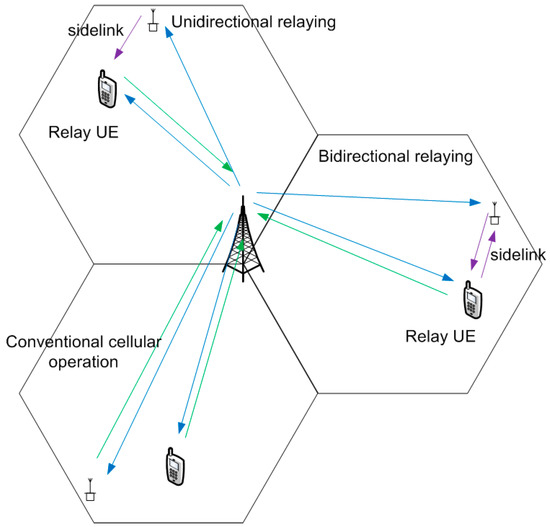
Figure 2.
Device-to-device (D2D) relaying variants for cellular Internet of Things (IoT) devices; UE: user equipment.
As a result of the 3GPP study, a relaying architecture was proposed. Relaying is done above the radio link control (RLC) layer, i.e., the RLC and lower layers are terminated at the D2D link and higher layers at the remote UE and the eNB [33]. Several solutions for paging and system information transfer for remote UEs as well as path switch and group handover enhancements were also proposed. These layer 2 studies mostly assumed the feasibility of bidirectional relaying; the impact of unidirectional relaying was not fully analyzed in the study item. For example, the discovery procedure for the unidirectional relaying case with remote UEs only capable of receiving downlink (DL) signals was still left open. Another aspect in the 3GPP study was to study the required enhancements to sidelink physical layer operation. The target was to also enable the sidelink support for low-cost UEs with a limited bandwidth of one (narrowband IoT) or six (LTE-M) physical resource blocks (PRBs) and potentially with no sidelink reception capabilities [33]. Enhancements were proposed to the synchronization procedure such that the relay UE can act as a synchronization source for the remote UEs. Also, the needed enhancements for the support of unicast communications over the sidelink were identified and proposed for resource allocation, semi-persistent scheduling, power control, measurements and feedback for link adaptation. Based on the performance evaluation results presented in [33], especially the adaptive modulation and coding together with the adaptive number of sidelink transmissions provided a significant energy efficiency gain for the remote UEs.
There are still several open issues regarding D2D and UE relaying for cellular IoT. From the research point of view, the effect on the cell energy efficiency and the battery life-time for all involved devices has not been thoroughly studied. It is clear that with UE relaying, the devices willing to operate as relays consume more power than the remote UEs. However, the device power consumption model used in [33] was rather simplified and no clear view on the spatial distribution of the power consumption was achieved. The 3GPP has plans to continue the normative work on bringing the relaying support for cellular IoT and wearables into standards. Currently, the corresponding work item has been proposed, but it is yet unclear whether the work will take place in release 15 or 16 [44]. D2D communication support in different 3GPP releases is depicted in Figure 3.
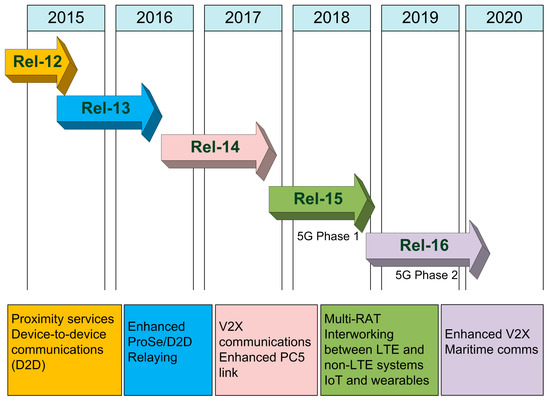
Figure 3.
D2D communications support in 3rd Generation Partnership Project (3GPP) releases; V2X: Vehicle-to-Everything; Rel: Release; RAT: Radio Access Technology.
2.2. Vehicle-to-Everything (V2X) and Maritime Communications
Another important area for D2D communications is vehicular communications or V2X communications that can be divided into three areas, namely vehicle-to-vehicle (V2V), vehicle-to-infrastructure (V2I), and vehicle-to-network (V2N) [9]. The V2V and V2I communications towards the other vehicles and roadside units (RSU) are handled through the PC5 interface in 3GPP networks. Connectivity to the network and the cloud (V2N) goes through the Uu interface (Air interface). V2X communications is included first time in Release 14.
Enhanced support for V2X services (eV2X) in 3GPP release 15 will include safety-related V2X scenarios, such as automated and remote driving and platooning, where vehicles form a platoon or a line travelling together [45]. It will also enable extended sensors where vehicles could exchange sensor information locally. A relevant aspect of advanced V2X applications is the level of automation (LoA), which reflects the functional aspects of the technology and affects the system performance requirements. The levels of automation are defined as: 0—No Automation, 1—Driver Assistance, 2—Partial Automation, 3—Conditional Automation, 4—High Automation, 5—Full Automation.
At lower automation levels a human operator is primarily responsible for monitoring the driving environment, whereas in higher layers an automated system is responsible for operations. Similar types of work are going on in the development of automated drones and autonomous and remote-controlled ships [8]. Currently 3GPP is considering and developing systems specifically for maritime communications for release 16 and beyond to support the needs of future maritime users [46]. One of the requirements of this “LTE-Maritime” system is to support 100 km coverage. It will also support the interworking between the 3GPP system and the existing/future maritime radio communication system for the seamless service of voice communication and data communication between users ashore and at sea or between vessels at sea.
3. System Model and D2D Use Cases for Combined LTE/5G and WiFi
Figure 4 presents our high-level system model for D2D communications in a 5G network. There are many types of users that are connected to the base stations using cellular interfaces. Nodes can also communicate directly using D2D communication links between nodes that are in proximity to each other. Direct links between user devices such as phones and laptops may use several RATs, including 3GPP evolution, as described in Section 2, Bluetooth, or WiFi standards. Cars also use a dedicated 802.11p standard in the intelligent transport system (ITS) band in 5.9 GHz for V2X communications. In the future, autonomous and remote-controlled ships will also use more and more ship-to-ship communications, possibly also radios specifically developed for these purposes. Both in the V2X communications among cars and in maritime communications, integrated 5G satellite-terrestrial systems will be needed [8,9].
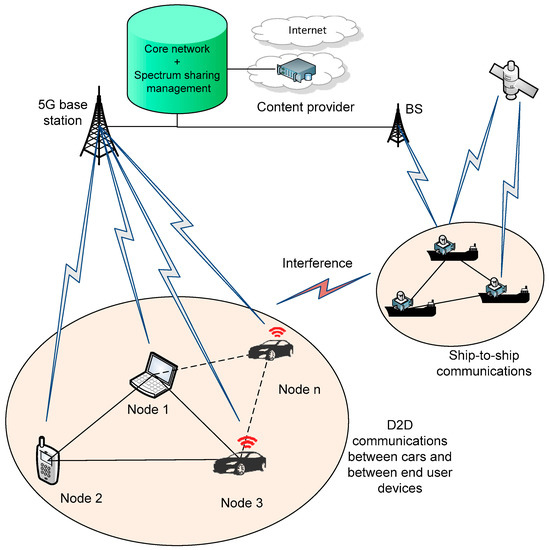
Figure 4.
High-level system model for D2D communications in 5G; BS: Base station.
The system has a connection to the Internet and the connectivity provider to make all the required services available to the end users. The 5G core supports seamless cooperation between different RATs and the terrestrial and satellite segments. It also enables QoS management of data transmission e.g., by dedicating part of the resources to applications with higher priority. There could even be end-to-end network slices dedicated to autonomous driving and other use cases so that QoS requirements can be met in any circumstances via proper resource allocation and isolation mechanisms. Network virtualization and slicing techniques enable different operators to share network resources with other (virtual) operators and to provide end-to-end connectivity across operator boundaries.
In addition to network management with the core network, the 5G networks will also use spectrum sharing technologies to utilize available radio resources as efficiently as possible. We assume a licensed spectrum access (LSA) approach, where the incumbent operators are required to provide a priori information about their spectrum use over the area of interest to the database. They tell explicitly where, when, and which parts of the frequency bands are available for the secondary use. This most probably requires a third party to operate the LSA system, since operators are often not willing to share the information about their spectrum use with other spectrum users.
Let us now look at the simplified model for the analysis that is presented in Figure 5. The model is based on the high-level system model described above. Wireless mobile users are connected to the base station using the LTE interface. There are N nodes in the network. We assume that links L12 (between Node 1 and Node 2), L13, L23, L3n can be either LTE or WiFi links. Only user equipment such as phones, tablets, and laptops are used as nodes in the network. Link attenuations between the base station and the user equipment are assumed to be equal, as well as the direct links between nodes. All the links between the user equipment and the base station are using 3GPP interfaces.
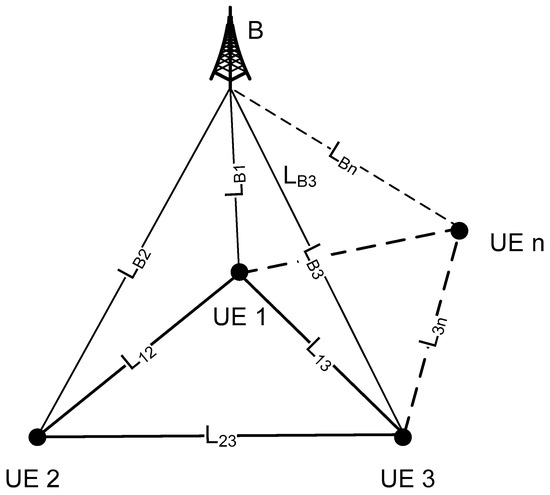
Figure 5.
Simplified model for analysis. LB1: Link between the base station and the UE 1; LB2: Link between the base station and the UE 2; LB3: Link between the base station and the UE 3; LBn: Link between the base station and the UE n; L12: D2D link between UE 1 and UE 2; L13: D2D link between UE 1 and UE 3; L23: D2D link between UE 2 and UE 3; L3n: D2D link between UE 3 and UE n.
D2D communication is controlled by the base station, which enables interference management and assures QoS to the end users. Nodes can form a cluster around the cluster head which may be the only node discussing with the base station. In order to estimate the power consumption in the depicted system model both from the user device and the base station perspectives, we need to define practical use cases for analysis. Based on Figure 5, we can define several different use cases for delivering Internet data or some other data from the content provider that certain node(s) want to access through the base station. Five different cases are described in the following as [30,31]:
- (1)
- Case 1: The base station sends the data directly to the requesting node(s).
- (2)
- Case 2: Nodes with social ties form a cluster. The base station sends the data to the cluster head that relays the data to other users over WiFi. The data (such as recently popular YouTube videos) is cached in the cluster head for some time in order to serve requesting nodes directly.
- (3)
- Case 3: The base station sends the data to the cluster head that relays the data to requesting nodes over LTE.
- (4)
- Case 4: The base station sends 1/N of the required packets to N different nodes requesting the same data (e.g., certain content in Facebook shared among friends). Different parts are sent to different users and the missing parts are shared using D2D connections among nodes over WiFi.
- (5)
- Case 5: Same as case 4, but the sharing is done using an LTE interface.
4. Power Consumption Models
4.1. LTE Base Station Model
The majority of the energy in wireless networks is consumed in the base stations, also in the defined cooperative scenarios. From the base station point of view, it is crucial to study the supply power consumption rather than radio frequency (RF) transmission power to see the total effect. Supply power consumption for a single RF chain showing the relation between supply power and RF transmission power is [21]:
where is the minimum active power consumption, is a linear transmission dependence factor, and is the power consumption in the sleep mode. When there are RF chains included, the total supply power consumption is
Measured parameter values of LTE base stations (macro, remote radio head, micro, pico, femto) can be found from [22]. The values are summarized in Table 1. The model and the values are based on commercially-available base stations, providing sufficient foundation for our energy estimations. We adopt this model since it is simple, based on vigorous measurements, and easy to use in the analysis. We note that there are also other models recently published, such as in [47], where a general conclusion is drawn as: “Modeling a linear dependence between the emitted power and the energy consumption, as well as between the traffic volume and the energy consumption, is a very good approximation, and it is strongly confirmed by real data”.

Table 1.
Base station power consumption parameters. Data from [22]; BS: Base station; : number of radio frequency (RF) chains; : Maximum transmission power; : Minimum active power consumption; : Power consumption in the sleep mode.
4.2. Model for LTE User Device
The power consumption (mW) when receiving data in a connected state is estimated as [18]:
where is the power consumption when the cellular subsystem is active, is the additional power consumption of a receiver being active. Parameter defines radio frequency (RF) block power consumption that is dependent on the received power and is the baseband power consumption, dependent on the received data rate . These parameters are given as
Equivalent power consumption (mW) when transmitting data in the connected state is given as:
where same parameters are defined for the transmitter side, respectively. Transmission power primarily affects the RF block power consumption:
The data rate does not affect baseband power consumption in the uplink, i.e., is constantly 0.62 mW. Other parameters are = 853 mW, = 25.1 mW and = 29.9 mW.
4.3. WiFi Power Consumption Models
The power consumption model for LTE and WiFi 802.11g air interfaces has linear dependency on the data rate in measurements done in [19], as shown in the following. Power consumption (mW) when receiving data is estimated as
The power consumption (mW) when transmitting data is estimated as
The parameters and are linear scaling factors for reception and transmission, is the received data rate, is the transmitted data rate and is the basic power consumption in the active mode. Based on several references, parameters for these models are given in Table 2. It can be seen that the older air interfaces behave according to Equations (5) and (6), including the LTE device model in [19] and the 802.11g model in the same paper. The more recent 802.11n model that was defined in [30] based on measurements reported in [20] is quite flat.

Table 2.
Power consumption parameters of different long term evolution (LTE) and WiFi models; : linear scaling factor for reception; : linear scaling factor for transmission; : basic power consumption in the active mode.
The most recent 802.11ac and 802.11ad measurements given in [32] show that both receiver power consumption and transmitter power consumption are almost flat, regardless of the bit rate. The basic power consumption is much lower in 802.11ac, but the 802.11ad interface always consumes a lot of energy when it is active. There is no big difference when receiving or transmitting data compared to the basic power consumption according to [32]. However, the results indicate that with the latest models, the best option for energy saving is to send the data with the best possible data rate in order to be able spend more time in the basic power consumption mode.
5. Performance Analysis
5.1. Power Consumption of the End User Device
Mathematically, the power consumption within the cooperative network in defined use cases can be given as follows: In case 1 the end user devices are only receiving the data using the LTE interface. Thus, the power consumption in this reference case is
where is the received signal power for a signal coming from the base station. In case 2, one node is receiving the data over the LTE link and transmits the data over WiFi to N-1 users, i.e.,
In case 3, the same transmissions are conducted over the LTE interface. Thus, the total power consumption is
where is the transmission power consumption of a UE and is the received power consumption for a D2D signal. R is the required data rate over the link. In cases 4 and 5, the data rate is divided into multiple R/N rate streams that are then combined at the requesting node(s). In case 4, the total power consumption is
and in case 5 it is
The power consumption of the cluster head is given in Equations (8) and (9) by excluding the last term in the equation. In cases 4 and 5, the power consumption is equally shared between the nodes.
5.2. Energy Consumption of a Base Station
Resource allocations in the time and frequency domains in the defined use cases are presented in Figure 6. Cooperation leads to a shorter active transmission period of the base station in all co-operative scenarios. The figure shows an example with two nodes (UEs) but the same model can be easily generalized to N users. The energy required for the transmission of data is the integral of the power consumption of the air interface over time
where the transmission duration T is dependent on the transmission size D and data rate R of the used air interface. We can now define the energy consumption for all defined cases as follows.

Figure 6.
Resource allocation from the BS perspective assuming two mobile devices. (A) Case 1, (B) Cases 2 and 3, and (C) Cases 4 and 5.
Case 1: Normal cellular case, data sent independently to N users. According to Equation (2) energy consumption is
Case 2 and Case 3 look the same from the base station perspective, since it sends all the data to a single relay. Clear energy savings are achieved especially if the same data is of interest to multiple users in a D2D enabled network. Energy consumption is now defined as
which means that the base station is able to reduce its active transmission time to one Nth of the time when compared with the Case 1 and then spend rest of the time in the sleep mode.
Again, Case 4 and Case 5 are the same from the base station perspective. Since the data is divided into independent pieces, the total amount of data transmitted by the base station is actually the same as in Case 2 and Case 3. Assuming that separating the interesting data to independent pieces does not consume significant amount of energy, we can use the same model for the base station power consumption as in Equation (14).
6. Results
6.1. Power Consumption of End User Devices
Figure 7, Figure 8 and Figure 9 show power consumption results with the defined power consumption models from the end user perspective. All used WiFi and LTE models are applicable to out-of-band D2D communication scenarios. In addition, the LTE models are applicable to in-band overlay D2D where D2D links use dedicated resources. The power consumption of the total D2D network, as well as the power consumption of the cluster head of a network in each case, is given in Figure 7 for a cluster size of N = 4 nodes using the Huang model [19] for the LTE and WiFi interfaces. It is seen that with the low throughput values it is best that only the cluster head actively receives the data from the LTE base station. Then it uses WiFi for relaying the data to requesting users. However, it can be seen that from the cluster head perspective this is the second most power consuming option and thus there might be a need to change the cluster head from time to time in order to prevent it draining the battery completely. When the higher throughput >6 Mbps is required, the most power efficient option from the end user perspective is to receive all the data directly from the base station.
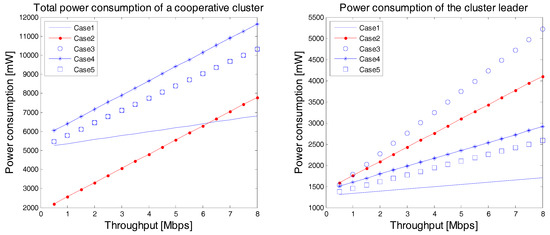
Figure 7.
Power consumption with the Huang LTE and WiFi models, 4 nodes; whole network (left) and the cluster leader (right).
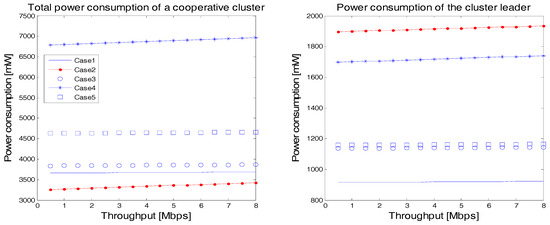
Figure 8.
Results with the Lauridsen LTE and the 802.11n WiFi; Power consumption of a whole network (left) and the cluster leader (right).
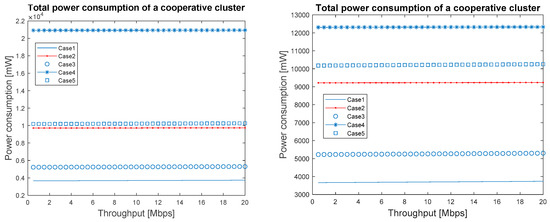
Figure 9.
Results with the Lauridsen LTE and the 802.11ac (left) and 802.11ad (right) WiFi, whole network considered.
When the Lauridsen model is adopted for LTE and 802.11n for WiFi, the observations are a bit different, as seen in Figure 8. We have assumed = −50 dBm and = 10 dBm for a D2D LTE link. The total power consumption in case 2 with a higher number of nodes is even more advantageous due to the lower power consumption of the WiFi. Case 4 demands the active operation of both LTE and WiFi interfaces. This is not good from the power consumption point of view due to the static part of the power consumption that comes from keeping the air interface active, i.e., in Equations (5) and (6). Thus, the latest power consumption models propose that dividing the data into smaller streams and changing the missing packets over the air is not efficient due to the simultaneous use of several active interfaces. WiFi relaying is a good option up to 20 Mbps data rate. However, also in this case, one has to take care that the cluster head is changed from time to time in a mobile network to keep all the nodes alive for longer periods of time.
The situation is quite similar when the 802.11ac and 802.11ad WiFi models are adopted as seen in Figure 9. The results cover the whole network and show that with the latest radios, where the power consumption is static regardless of the data rate, the best option is to use LTE alone. Either the conventional cellular operation or relaying with LTE are the best choices. This is due to the high power consumption of WiFi models with any data rate. An active WiFi interface consumes a lot of power. WiFi could be used to enhance the data rate of the devices if very high data rate services were needed.
The used models are applicable both to LTE and LTE-advanced systems. Only some parameter updates are needed e.g., regarding the power model given in the Equation (1). e.g., release 12 equipment in our lab uses the old HW and only the SW is updated in the base station compared to the older releases. Power consumption is affected by the software as well, but the LTE-A base station power consumption can be described with the same model due to the slow evolution of the devices.
6.2. Base Station Energy Consumption in D2D Networks
The energy consumption of cooperative scenarios from the base station perspective is the same for all depicted D2D scenarios. Thus, we compare here conventional cellular operation with the cooperative scenario as a function of number of nodes in a D2D network. We adopt the energy consumption metric J/bit [22] that focuses on the amount of energy spent per delivered bit and is hence an indicator of network bit delivery efficiency.
We assume an average bit rate of 10 Mbit/s in the following figures and use the energy consumption models of Equations (13) and (14). The transmission power is set according to the values in Table 2. The results presented in Figure 10 for a macro base station show that with this data rate conventional cellular transmission consumes roughly 0.3 J/kbit, whereas the cooperation clearly reduces the energy consumption by sharing the load among cooperative nodes. The effect is the largest with a few additional cooperative nodes, three nodes already lead to 50% energy savings. When the number of nodes is increased to more than 10 nodes, the energy consumption of a base station is around 0.1 J/kbit which means that the base station is able to serve the requesting nodes with one third of the original energy. This is a significant improvement in the energy efficiency.
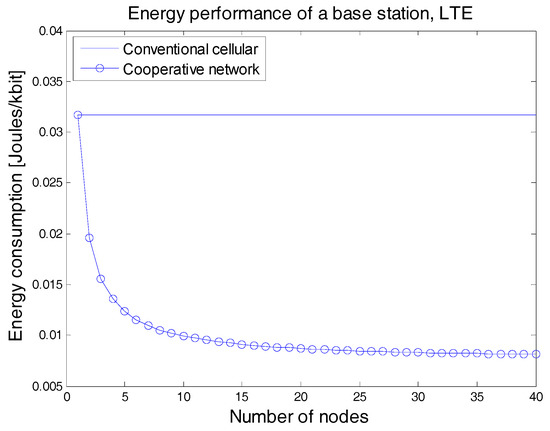
Figure 10.
Energy consumption of a macro base station.
When the cell size is smaller, the energy efficiency improvement is smaller, as can be seen in Figure 11 and Figure 12. Still, even with the small cell base stations the energy reduction is around 40%, which is significant saving already with a few requesting nodes. The results suggest that cooperative D2D data dissemination approaches are good for cellular network energy efficiency. The gain is dependent on the D2D link quality, and with poor D2D links the energy savings would be smaller.
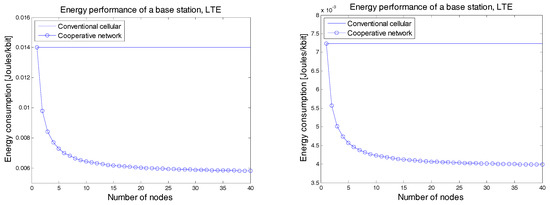
Figure 11.
Energy consumption of a remote radio head (left) and a micro base station (right).
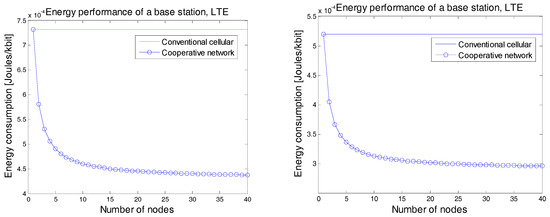
Figure 12.
Energy consumption of pico (left) and femto (right) base stations.
7. Recommendations
Based on the conducted analysis, the following recommendations can be made for network deployment and operations:
- (1)
- When the power consumption is dependent on the data rate (as in Figure 7), the aim should be to find the sweet spots or data rate regions to use different air interfaces. In multi-RAT 5G networks this would mean analysis of all other radio interface options than the ones analyzed in this paper. However, the most important ones currently are the LTE and WiFi.
- (2)
- With the latest WiFi and LTE models, the best option for cooperative data delivery is to select a relay and then use LTE for D2D transmissions. WiFi is a good option only for very high data rates.
- (3)
- The base station results show that D2D transmission brings the largest gains in macro cells, up to 70% energy reductions. Small cells are already more energy efficient, but energy savings can still be significant, even 40% in the case of femto cells. Thus, it is recommended to use direct communication between devices in all cellular networks regardless of the type of base station.
- (4)
- The best option for energy saving in D2D communications using the latest LTE and WiFi models is to send the data with the best possible data rate.
- (5)
- There is clearly room for the creation of novel models with the latest 3GPP releases after rigorous power consumption measurement work. The measurements should specifically consider D2D measurements with the release 12 and beyond devices.
8. Conclusions
Energy efficiency is an important factor in 5G and beyond networks and one of the drivers in the adoption of D2D technology. This paper has reviewed the potential application areas including IoT, wearables, and automated driving and reviewed the current status of D2D technology in 3GPP standardization. In addition, we have analyzed D2D-enhanced cellular networks both from the base station and from the end user perspectives. The analysis is conducted with several different measurement-based LTE and WiFi models. The results show that significant energy reductions can be achieved with all types of base stations, including macro, pico, and femto base stations. The results also suggest that in order to minimize power consumption, the devices should minimize the number of active radio interfaces and use the best possible data rates. In our system model this means that either a LTE or WiFi interface is active in a single device at a given time instant. WiFi could be used to support very high data rate services. If there is no need for that, one should keep only the LTE interface active in order to save power. An interesting future topic could be to study the effect of mobility in energy consumption. This would create new challenges e.g., due to frequent handovers in a multi-RAT network. In addition, adaptive power control could be included in the analysis to gain a more detailed understanding e.g., on the effect of UL transmissions.
Acknowledgments
This work was supported by the CORNET project, partly funded by Tekes, the Finnish Funding Agency for Innovation.
Author Contributions
Marko Höyhtyä performed the experiments and analyzed the data. He was also the main author of the paper. Olli Apilo wrote a major part of the 3GPP section, especially regarding the IoT and wearables. Mika Lasanen commented on and supported work throughout the paper.
Conflicts of Interest
The authors declare no conflict of interest.
References
- Adachi, T.; Nakagawa, M. A study on channel usage in a cellular Ad-Hoc united communication system. IEICE Trans. Commun. 1998, 81, 1500–1507. [Google Scholar]
- 3rd Generation Partnership Project (3GPP). TR 36.843 V12.0.1, Study on LTE Device to Device Proximity Services, Release 12. March 2014. Available online: http://www.3gpp.org/ftp/Specs/archive/36_series/36.843/36843-c01.zip (accessed on 27 December 2017).
- Asadi, A.; Wang, Q.; Mancuso, V. A survey on device-to-device communication in cellular networks. IEEE Commun. Surv. Tutor. 2014, 16, 1801–1819. [Google Scholar] [CrossRef]
- Usman, M.; Gebremariam, A.A.; Raza, U.; Granelli, F. A software-defined device-to-device communication architecture for public safety applications in 5G networks. IEEE Access 2015, 3, 1649–1654. [Google Scholar] [CrossRef]
- Gallo, L.; Härri, J. Unsupervised long-term evolution device-to-device: A case study for safety critical V2X communications. IEEE Veh. Technol. Mag. 2017, 12, 69–77. [Google Scholar] [CrossRef]
- Bello, O.; Zeadally, S. Intelligent device-to-device communication in the Internet-of-Things. IEEE Syst. J. 2016, 10, 1172–1182. [Google Scholar] [CrossRef]
- Alam, M.M.; Arbia, D.B.; Hamida, E.B. Research trends in multi-standard device-to-device communication in wearable wireless networks. In Proceedings of the International Conference on Cognitive Radio Oriented Wireless Networks, Doha, Qatar, 21–23 April 2015. [Google Scholar]
- Höyhtyä, M.; Huusko, J.; Kiviranta, M.; Solberg, K.; Rokka, J. Connectivity for autonomous ships: Architecture, use cases, and research challenges. In Proceedings of the 8th International Conference on ICT Convergence, Jeju Island, Korea, 18–20 October 2017. [Google Scholar]
- Höyhtyä, M.; Ojanperä, T.; Mäkelä, J.; Ruponen, S.; Järvensivu, P. Integrated satellite-terrestrial systems: Use cases for road safety and autonomous ships. In Proceedings of the 23rd Ka and Broadband Communications Conference, Trieste, Italy, 16–19 October 2017. [Google Scholar]
- Cisco Systems, Inc. Cisco Visual Networking Index: Global Mobile Data Traffic Forecast Update, 2016–2021 White Paper; Cisco: San Jose, CA, USA, 7 February 2017; Available online: https://www.cisco.com/c/en/us/solutions/collateral/service-provider/visual-networking-index-vni/mobile-white-paper-c11-520862.pdf (accessed on 22 December 2017).
- Chen, T.; Yang, Y.; Zhang, H.; Kim, H.; Horneman, K. Network energy saving technologies for green wireless access networks. IEEE Wirel. Commun. 2011, 18, 30–38. [Google Scholar] [CrossRef]
- Zhang, J.; Wang, Z.-J.; Quan, Z.; Yin, J.; Chen, Y.; Guo, M. Optimizing power consumption of mobile devices for video streaming over 4G LTE networks. Peer-to-Peer Netw. Appl. 2017. [Google Scholar] [CrossRef]
- Militano, L.; Iera, A.; Molinaro, A.; Scarcello, F. Energy-saving analysis in Cellular-WLAN cooperative scenarios. IEEE Trans. Veh. Technol. 2014, 63, 478–484. [Google Scholar] [CrossRef]
- Rao, J.B.; Fapojuwo, A.O. A survey of energy efficient resource management techniques for multicell cellular networks. IEEE Commun. Surv. Tutor. 2014, 16, 154–180. [Google Scholar] [CrossRef]
- Mämmelä, A.; Anttonen, A. Why will computing power need particular attention in future wireless devices? IEEE Circuits Syst. Mag. 2017, 17, 12–26. [Google Scholar] [CrossRef]
- Caire, G.; Taricco, G.; Biglieri, E. Optimum power control over fading channels. IEEE Trans. Inf. Theory 1999, 45, 1468–1489. [Google Scholar] [CrossRef]
- Höyhtyä, M.; Mämmelä, A. A unified framework for adaptive inverse power control. EURASIP J. Wirel. Commun. Netw. 2016, 2016, 41. [Google Scholar] [CrossRef]
- Lauridsen, M.; Noël, L.; Sørensen, T.B.; Mogensen, P. An empirical LTE smartphone power model with a view to energy efficiency evolution. Intel Technol. J. 2014, 18, 172–193. [Google Scholar]
- Huang, J.; Qian, F.; Gerber, A.; Mao, Z.M.; Sen, S.; Spatscheck, O. A close examination of performance and power characteristics of 4G LTE networks. In Proceedings of the 10th Mobile Systems, Applications, and Services, Low Wood Bay, UK, 25–29 June 2012. [Google Scholar]
- Saha, S.K.; Deshpande, P.; Inamdar, P.P.; Sheshadri, R.K.; Koutsonikolas, D. Power-throughput tradeoffs of 802.11n/ac smartphones. In Proceedings of the 2015 IEEE Computer Communications (INFOCOM), Hong Kong, China, 26 April–1 May 2015. [Google Scholar]
- Holtkamp, H.; Auer, G.; Bazzi, S.; Haas, H. Minimizing base station power consumption. IEEE J. Sel. Areas Commun. 2014, 32, 297–306. [Google Scholar] [CrossRef]
- EARTH Project Deliverable D2.3. Energy Efficiency Analysis of the Reference Systems, Areas of Improvements and Target Breakdown. January 2012. Available online: http://cordis.europa.eu/docs/projects/cnect/3/247733/080/deliverables/001-EARTHWP2D23v2.pdf (accessed on 22 December 2017).
- Zuo, X.; Iamnitchi, A. A survey of socially aware peer-to-peer systems. ACM Comput. Surv. 2016, 49, 9. [Google Scholar] [CrossRef]
- Gupta, M.; Jha, S.C.; Koc, A.T.; Vannithamby, R. Energy impact of emerging mobile Internet applications on LTE networks: Issues and solutions. IEEE Commun. Mag. 2013, 51, 90–97. [Google Scholar] [CrossRef]
- Koc, A.T.; Jha, S.C.; Vannithamby, R.; Torlak, M. Device power saving and latency optimization in LTE-A networks through DRX configuration. IEEE Trans. Wirel. Commun. 2014, 13, 2614–2625. [Google Scholar]
- Larsson, E.G.; Edfors, O.; Tufvesson, F.; Marzetta, T.L. Massive MIMO for next generation wireless systems. IEEE Commun. Mag. 2014, 52, 186–195. [Google Scholar] [CrossRef]
- Lei, L.; Zhong, Z.; Lin, C.; Shen, X. Operator controlled device-to-device communications in LTE-Advanced networks. IEEE Wirel. Commun. 2012, 19, 96–104. [Google Scholar] [CrossRef]
- Chih-Lin, I.; Rowell, C.; Han, S.; Xu, Z.; Li, G.; Pan, Z. Toward green and soft: A 5G perspective. IEEE Commun. Mag. 2014, 52, 66–73. [Google Scholar]
- Zhang, H.; Huang, S.; Jiang, C.; Long, K.; Leung, V.C.M.; Poor, H.V. Energy efficient user association and power allocation in millimeter-wave-based ultra dense networks with energy harvesting base stations. IEEE J. Sel. Areas Commun. 2017, 35, 1936–1947. [Google Scholar] [CrossRef]
- Höyhtyä, M.; Mämmelä, A.; Celentano, U.; Röning, J. Power-efficiency in social-aware D2D communications. In Proceedings of the European Wireless 2016 22th European Wireless Conferences, Oulu, Finland, 18–20 May 2016. [Google Scholar]
- Höyhtyä, M.; Mämmelä, A. Energy-efficiency in social-aware D2D networks: A base station perspective. In Proceedings of the 2016 Advances in Wireless and Optical Communications (RTUWO), Riga, Latvia, 3–4 November 2016. [Google Scholar]
- Saha, S.K.; Siddiqui, T.; Koutsonikolas, D.; Loch, A.; Widmer, J.; Sridhar, R. A detailed look into power consumption of commodity 60 GHz devices. In Proceedings of the 2017 IEEE 18th International Symposium on A World of Wireless, Mobile and Multimedia Networks (WoWMoM), Macau, China, 12–15 June 2017. [Google Scholar]
- 3rd Generation Partnership Project (3GPP). TR36.746 Study on Further Enhancements to LTE Device to Device (D2D), UE to Network Relays for IoT (Internet of Things) and Wearables, V2.0.1. October 2017. Available online: http://www.3gpp.org/ftp//Specs/archive/36_series/36.746/36746-201.zip (accessed on 27 December 2017).
- 3rd Generation Partnership Project (3GPP). TS29.214 Policy and Charging Control over Rx Reference Point, V14.3.0. March 2017. Available online: http://www.3gpp.org/ftp//Specs/archive/29_series/29.214/29214-e30.zip (accessed on 27 December 2017).
- Rost, P.; Mannweiler, C.; Michalopoulos, D.S.; Sartori, C.; Sciancalepore, V.; Sastry, N.; Holland, O.; Tayade, S.; Han, B.; Bega, D.; et al. Network slicing to enable scalability and flexibility in 5G mobile networks. IEEE Commun. Mag. 2017, 55, 72–79. [Google Scholar] [CrossRef]
- Zhang, H.; Liu, N.; Chu, X.; Long, K.; Aghvami, A.-H.; Leung, V.C.M. Network slicing based 5G and future mobile networks: Mobility, resource management, and challenges. IEEE Commun. Mag. 2017, 55, 138–145. [Google Scholar] [CrossRef]
- Lin, X.; Andrews, J.G.; Ghosh, A.; Ratasuk, R. An overview of 3GPP device-to-device proximity services. IEEE Commun. Mag. 2014, 52, 40–48. [Google Scholar] [CrossRef]
- Mach, P.; Becvar, Z.; Vanek, T. In-band device-to-device communication in OFDMA cellular networks: A survey and challenges. IEEE Commun. Surv. Tutor. 2015, 17, 1885–1992. [Google Scholar] [CrossRef]
- Rohde & Schwarz. Device to Device Communication in LTE; Rohde & Schwartz Whitepaper; Rohde & Schwarz USA, Inc.: Columbia, MD, USA, 2015. [Google Scholar]
- 3rd Generation Partnership Project (3GPP). RP-170295 Study on Further Enhancements to LTE Device to Device, UE to Network Relays for IoT and Wearables. March 2017. Available online: http://www.3gpp.org/ftp/tsg_ran/TSG_RAN/TSGR_75/Docs/RP-170295.zip (accessed on 27 December 2017).
- 3rd Generation Partnership Project (3GPP). TS 22.261 Service Requirements for the 5G System, V16.0.0. June 2017. Available online: http://www.3gpp.org/ftp//Specs/archive/22_series/22.261/22261-g00.zip (accessed on 27 December 2017).
- 3rd Generation Partnership Project (3GPP). RP-161313 Report of 3GPP TSG RAN Meeting #71. June 2016. Available online: http://www.3gpp.org/ftp/tsg_ran/TSG_RAN/TSGR_72/Docs/RP-161313.zip (accessed on 27 December 2017).
- Roessel, S.; Sesia, S. Cellular Internet-of-Things—Explained. In Proceedings of the IEEE Globecom Conference, Washington, DC, USA, 4–8 December 2016. [Google Scholar]
- 3rd Generation Partnership Project (3GPP). RP-172119 Draft Report of 3GPP TSG RAN Meeting #77. December 2017. Available online: http://www.3gpp.org/ftp/TSG_RAN/TSG_RAN/TSGR_78/Docs/RP-172119.zip (accessed on 27 December 2017).
- 3rd Generation Partnership Project (3GPP). TS22.186 Enhancement of 3GPP Support for V2X Scenarios, V.15.2.0. September 2017. Available online: http://www.3gpp.org/ftp//Specs/archive/22_series/22.186/22186-f20.zip (accessed on 27 December 2017).
- 3rd Generation Partnership Project (3GPP). TR 22.819 Feasibility Study on Maritime Communication Services over 3GPP System, V0.3.0. August 2017. Available online: http://www.3gpp.org/ftp//Specs/archive/22_series/22.819/22819-030.zip (accessed on 27 December 2017).
- Capone, A.; D’Elia, S.; Filippini, I.; Redondi, A.E.C.; Zangani, M. Modeling energy consumption of mobile radio networks: An operator perspective. IEEE Wirel. Commun. 2017, 24, 120–126. [Google Scholar] [CrossRef]
© 2018 by the authors. Licensee MDPI, Basel, Switzerland. This article is an open access article distributed under the terms and conditions of the Creative Commons Attribution (CC BY) license (http://creativecommons.org/licenses/by/4.0/).